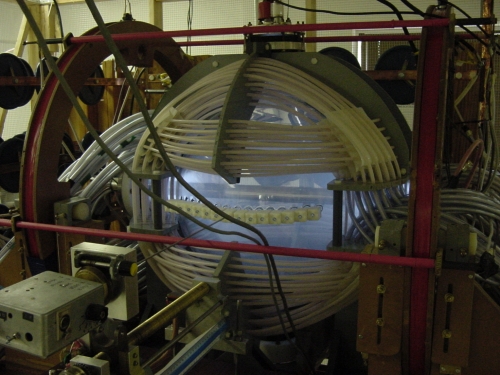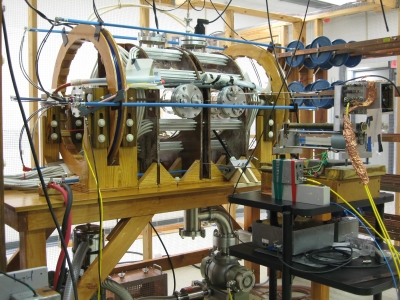Rotamak is a compacted device that can form and sustain a field-reversed configuration (FRC) hich does not have an externally toroidal magnetic field, and the spherical tokamak (ST) which possesses such a field, and the steady toroidal plasma current is driven by means of an externally applied rotating magnetic field (RMF). Sufficiently large plasma current can be generated to reverse the external equilibrium magnetic field on the symmetry axis, so that a field reversed configuration (FRC) is formed. Such configuration is considered as a promising alternative for a fusion reactor because of its compact and simple design, natural divertor, and high plasma beta.

Experimental Program
- The Rotamak delivered from Flinders University of Australia in 2001 has been rebuilt at PVAMU. Plasma experiments with current driven by a rotating magnetic field were conducted since 2002.
- In 2006, another device has been built. The main goal is to study the physics of magnetic reconnection. The plasma current is generated by Rotating Magnetic Field and severed into two current rings by brief application of external magnetic field at the midplane.
- Typical plasma parameters:Te~ 20-40 eV, ne~ up to 2×1012 cm-3, Iplasma~ up to 10 kA.

Laboratories and Equipment
Theory and Computations
- A new model – the guiding field line model – has been developed. The model is powerful for calculating the current and flow velocity in plasma.
- Numerical codes available:
- Code for tracing the particle drift trajectories in a real 3D geometry of a tokamak.
- Monte-Carlo simulation of Coulomb collisions and radio – frequency heating.
- Ray-tracing code for description of propagation and damping of waves in toroidal plasmas.
- MHD-e code for description of rotating magnetic field and current penetration into plasma.
References
- T.S. Huang, J. Geophys. Res., Vol. 105, p. 5541, (2000).
- Yu. Petrov and T.S. Huang, Phys. Plasmas, Vol. 7, p. 4095, (2000).
- Yu. Petrov and T.S. Huang, Plasma Physics and Controlled Fusion, Vol. 44, p. 1483, (2002).
- Yu. Petrov and T.S. Huang, Nuclear Fusion, Vol. 43, p. 130, (2003).
- F.C. Zhong, Yu. Petrov and T.S. Huang, Phys. Plasmas, N.4, p.L1-L4, (2004).
- Yu. Petrov, F.C. Zhong, and T.S. Huang,Observation of the self-generated toroidal magnetic field in rotamak,Physics of Plasmas, Vol. 12, N.8, p. 082514, (2005).
- T.S. Huang, Yu. Petrov, and F.C. Zhong,Comparison of rotamak plasmas in FRC and ST configurations,Plasma Physics and Controlled Fusion, Vol. 47, N.9, p. 1517, (2005).
Team Members
- Vacant (Director)
Research Collaboration
- Princeton Plasma Physics Laboratory
- Oak Ridge National Laboratory
- Flinders University
